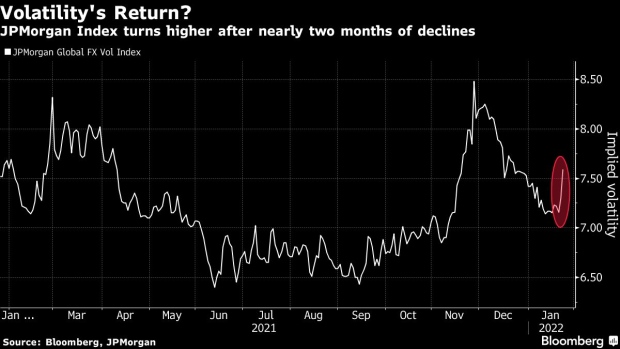Jan 24, 2022
Volatility Runs From Stocks to Currencies, Ending FX Market Calm
, Bloomberg News

(Bloomberg) -- Volatility has surged back in the world’s currency markets, ending nearly nearly two months of diminishing price swings.
JPMorgan Chase & Co.’s Global FX Volatility Index, which tracks three-month option volatilities, on Monday posted its largest gain since late November as stocks tumbled globally, sending investors rushing into havens, before U.S. shares rallied back to close up on the day. The same shift was seen in the G7 volatility index, which tracks the greenback’s developed-market peers.
The price swings echo the volatility that is racing through financial markets more broadly as traders prepare for an end to the extremely loose monetary policy the Federal Reserve has had in place since the pandemic hit. The Chicago Board of Options Exchange Volatility Index, a measure of expected stock-price swings, surged by the most since November earlier Monday before pulling back as prices recovered. The Nadaq Composite Index swung from a loss of as much as 4.9% to surge back to a gain of 0.6% on the day.
In the foreign-exchange market, the biggest shifts in implied volatility came for risk-sensitive developed-market currencies like the Australian, Canadian and New Zealand dollars, as commodity prices slipped with U.S. equities and other risk assets. All Group-of-10 currencies were lower against the greenback on the day, as the Bloomberg Dollar Index rose as much as 0.5%, its largest gain since the first trading day of the year.
That marks a break for currency markets that have been in a period of relative calm since late November. Some analysts have been expecting foreign-exchange swings to become more pronounced, as they have been for stocks and bonds.
©2022 Bloomberg L.P.


